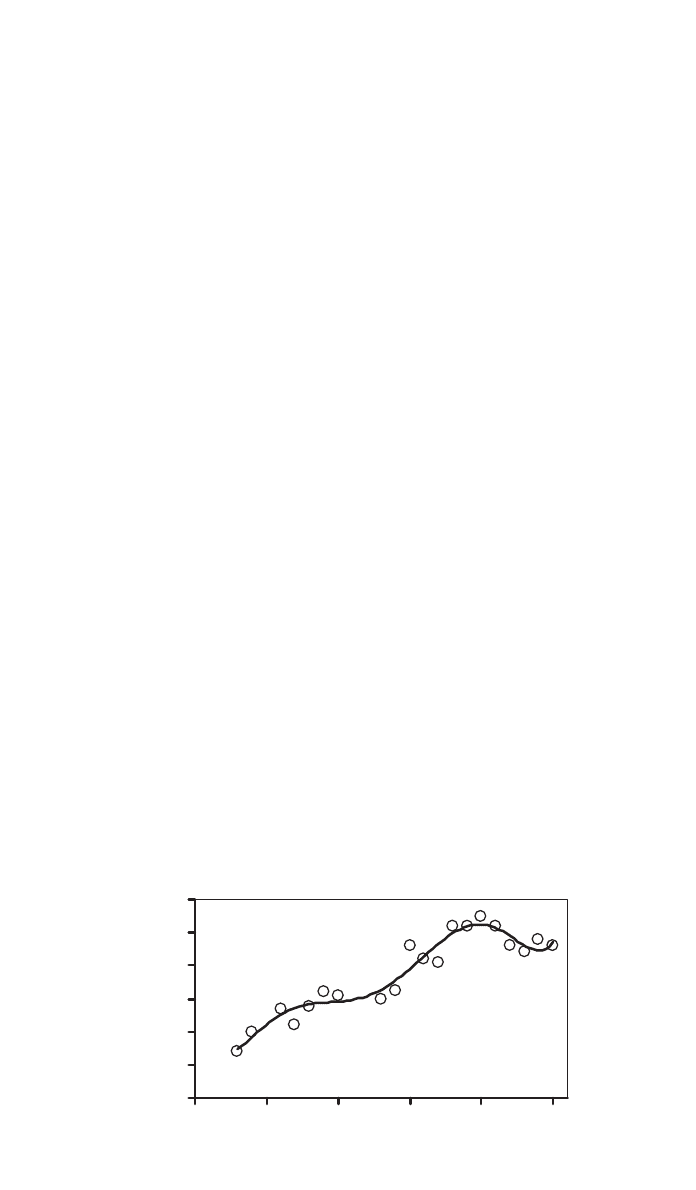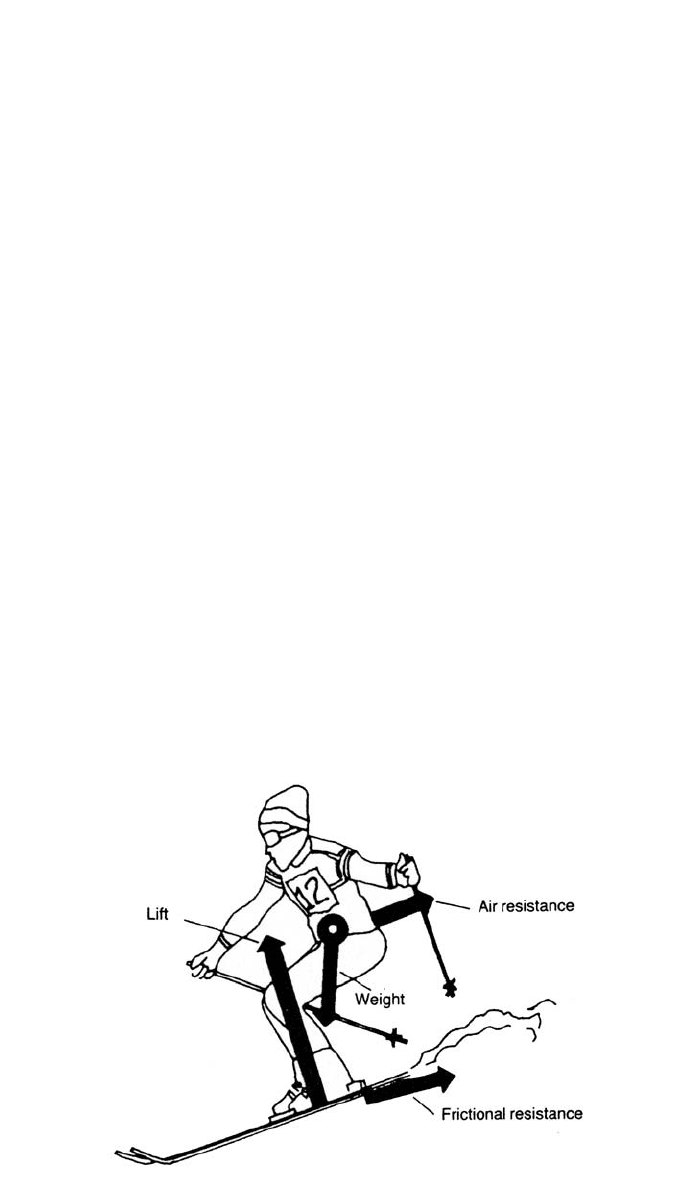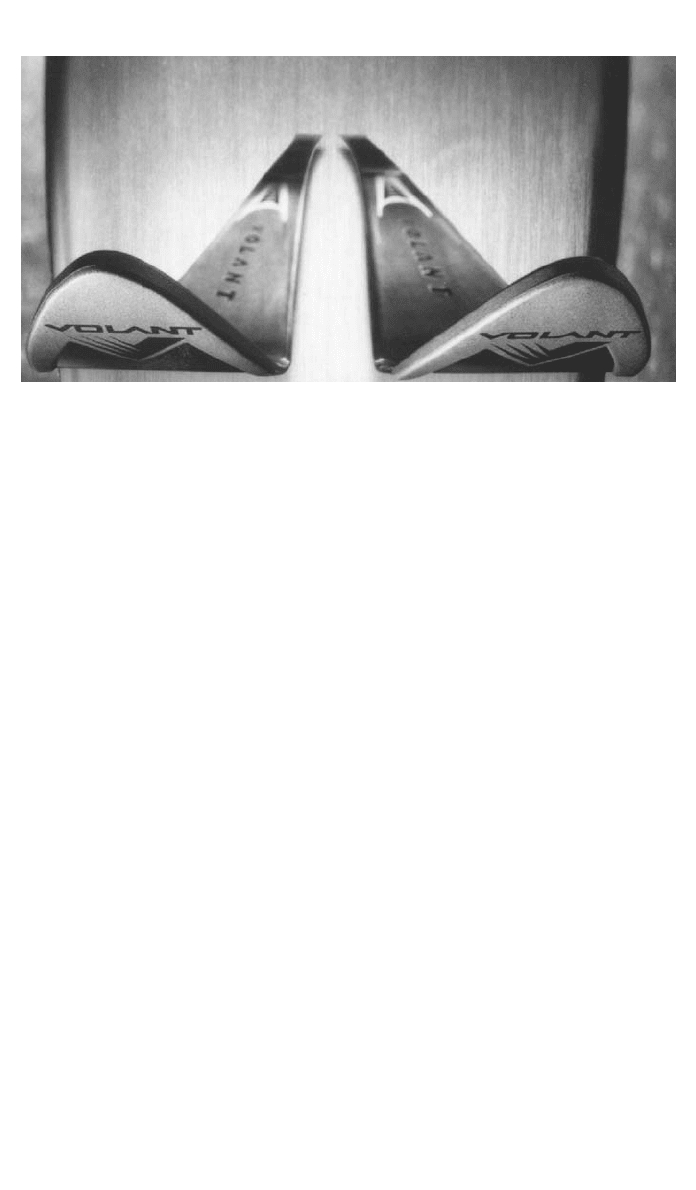Kutz M. Handbook of materials selection
Подождите немного. Документ загружается.


3 THE IMPACT OF ADVANCED MATERIALS ON SPORTS PERFORMANCE 1269
40
50
60
70
80
90
100
1896 1916 1936 1956 1976 1996
Date
Distance (m)
Fig. 17 Winning Olympic Games javelin throws.
ture but is sufficiently strong to deform the elastomer region. As a result, the
cross section will assume the cambered geometry shown. If a satisfactory shape
is achieved, the end result will be an increase in lift-to-drag ratio of the fin—
one of the design parameters used to improve the fin performance. The material
of choice here is carbon fiber/Kevlar polymer composite.
3.9 Javelin
The javelin was an event enjoyed by the Mycenaeans at least 3000 years ago.
17
The Greeks of 500 BC used a thin wooden javelin with a cord wrapped around
its center of mass. When thrown, the thrower held onto the end of the cord to
make the javelin rotate through the air. The rotation acted to stabilize the javelin
by averaging any non-symmetry in its construction about a central axis.
The modern javelin has relatively strict rules concerning its construction.
17
Essentially, the modern javelin must be smooth and has strict geometric rules to
ensure the positioning of the center of mass. The reason for this can be seen in
Fig. 17 which shows winning throws at the Olympic Games from 1904 onward.
At the Athens Olympic Games in 1908 the winning throw was just over 50 m.
In 1984, Uwe Hohn (from the then East Germany) threw a staggering 104.80
m. Given the dimensions of stadia and the fact that it was becoming unsafe for
spectators, it was decided fairly quickly by the International Amatuer Athletics
Federation that the javelin had to be redesigned to ‘‘under-perform.’’ This was
done by moving the center of mass forward by 4 cm, which caused a dramatic
loss in lift and a consequent reduction in the distance traveled.
Figure 17 shows that the distances for the new-rules javelin were approxi-
mately 15 m less after the center of mass rule change. As far as the rule makers
are concerned there are two advantages: (1) the javelin does not fly as far and
(2) the javelin clearly lands tip first. Although this reduces overall throw dis-
tances, the new rule does give the athlete one advantage. The old-rules javelin
was very sensitive to the initial throw conditions and even a small change could
reduce distances by 20 m. The new-rules javelin is much less sensitive to initial
conditions partly because it always has a negative pitching moment. This is
likely to allow the athlete to produce more consistent throws.

1270 ADVANCED MATERIALS IN SPORTS EQUIPMENT
Fig. 18 Forces acting on a skier. (From Ref. 2.)
As with the pole vault, technology strongly influences the performance of
javelin throwers, and the IAAF successfully used an equipment change to reduce
the length of throws from the mid 1980s. As Fig. 17 shows, however, it might
not be too long until a further rule change is required!
3.10 Skiing and Boards
Skis need to provide for good longitudinal torsional rigidity to allow for good
weight/pressure distribution while being flexible enough to respond to different
surface properties (snow conditions) to dampen vibrations that could lead to hip
and knee injuries (Fig. 18).
2
Modern skis consist of a cellular core (of polymeric
or metal construction) and layered material around this core (including metals
and polymer composites reinforced with Kevlar, aramid, and carbon fibers) with
metal edges of steel or high-strength aluminum alloys. Debatably, the top-of-
the-line skis, at the present time is the Volant titanium model, again with steel
edges for high hardness, toughness, and wears resistance
18
(Fig. 19).
3.11 Hockey Equipment
The hockey stick has changed dramatically over the years, transitioning from
wooden handles and paddles to hybrids of wood and fiberglass composites, and
recently to include aluminum and carbon or graphite composite shafts.
19
The
latter concept giving improved performance and player comfort.
4 ETHICAL CONSIDERATIONS
The use of advanced materials in sporting goods has been discussed with some
examples being given; but certainly not all that are possible. Where the sporting
achievement can be gauged in absolute terms, tremendous improvements have
been made in those sports where equipment is critical. However, use of advanced
materials in sports equipment presents us with some ethical questions.
20
We can
clearly enhance behavior by allowing the use of advanced materials, but where

4 ETHICAL CONSIDERATIONS 1271
Fig. 19 Volant titanium skis.
should the line be drawn? Or should there be no restrictions? The solution,
according to a young man in one of my classes at the University of Idaho, is
that if you have the patent, you (and only you) can use this material or design
no matter what it is.
This then brings us to a second question. Should we allow competition at the
highest level to be only affordable to the elite because of the high cost of equip-
ment? In turn this leads into what is perhaps the most controversial question. If
we allow certain classes of materials and designs, but not others, we can actually
favor the class of people who will excel! Let us briefly examine these questions.
The carbon fiber vaulting pole, javelins with spiral tails, golf balls with special
dimple patterns, stiffer carbon fiber tennis rackets, bicycles with new types of
wheels, and the ‘‘egg position,’’ discuses with their weight distributed as close
as possible to their perimeter, and America’s Cup yachts (forget it, this one is
too complex) all lead to ‘‘further and faster.’’ We should not be Luddites but
where should this end? Can we ensure that it is people who are competing and
not the advanced materials? For sure, we do not want to force the paraplegic
athlete to go back to a wooden pylon. But how about electronically guided darts,
heat-seeking missiles for grouse shooting (allowable, provided the grouse is still
edible, according to a young lady in one of my classes at the University of
Idaho), solar-energy-enhanced bicycles, and terrain-following golf balls, which
automatically find the lowest local elevation on a putting surface (the bottom of
the hole).
Returning to running, consider the advanced devices that allow the runner to
be catapulted forward more efficiently than if he were running on two human
feet (cost up to $7000). So let’s develop similar devices to be incorporated into
the shoes of Donovan Bailey (winner of the 100 m in Atlanta in a world record
9.84 s) and Michael Johnson (winner of the 200 m in Atlanta in a world record
of 19.32 s). Any bets on whether Donovan and Michael could then break 9 s
and 18 s in their respective events? Is the answer here that nothing beyond the
‘‘natural’’ springiness should be allowed?

1272 ADVANCED MATERIALS IN SPORTS EQUIPMENT
What is the answer to high costs? Many sports rules committees feel that a
reasonable compromise is to keep their sport affordable to many athletes rather
than the elite few. For example, disk wheels were initially banned from Olympic
bicycling competition because they were so expensive that they could not be
considered as available to most cyclists. Should all canoes and kayaks conform
to a single-hull design? Should the ‘‘Hoyt bow,’’ comprised of tiny glass beads
embedded in a rigid foam matrix, be allowed to compete against the traditional
wooden bow? The lack of change in behavior with temperature and minimal
moisture absorption of the new bow has led to winning scores of 1350 (out of
1440) compared to about 1100 thirty years ago—but at a price.
Let us take two examples of how legislation regarding advanced materials
can significantly determine who wins an event. Elite rowers stand 6 ft 6 in. and
weigh about 210 lb. In contrast elite kayakers stand 6–12 in. smaller and weigh
30 lb less. This relates to allowable boat dimensions—a rowing boat can be as
long as desired, favoring strength even at higher weights (longer boats can dis-
tribute more weight over a larger area without riding too low in the water, which
leads to excessive drag). In contrast the length of a kayak is restricted, leading
to an optimized aerobic strength-to-weight ratio.
When the javelin was redesigned to be lighter and more aerodynamic, finesse
was required to make it ‘‘float’’ correctly. Masters of this new art, such as Uwet-
lohn of East Germany (1984), deftly projected the javelin over 100 m, much to
the danger of spectators and other athletics warming up on the far side of the
stadium. The 1986 ban on the new design led to a dramatic drop in the world
record by 20 m, with the ‘‘finesse floater’’ fading to the second rank, and the
‘‘strong-arm boys’’ once again leading the way.
Lots of questions, few answers.
5 CONCLUDING REMARKS
In this chapter, I have chosen a number of sporting events to illustrate how the
magnitude of the effect of advanced materials differs depending upon the sport
in question. I then presented some ethical issues regarding the use of advanced
materials in sports, with the issues outnumbering the answers. Clearly different
sports have been affected by quite different amounts, in some cases to an extent
that has required legislation restricting certain materials and designs (titanium
baseball bats, floating javelins, nonconforming golf club drivers, etc.). However,
perhaps the best approach would be to define acceptable performance standards
rather than the conventional ad hoc regulation focused on design standards.
11
This should protect the essential skills of the sport, preventing it from becoming
too easy or distancing it from historic or aesthetic origins. For further details on
the use of advanced materials in sports, the interested reader is referred to two
recent conference proceedings.
21,22
Acknowledgments
The author would like to thank C. Shira, S. Haake, S. Fagg, K. A. Prisbrey, K.
Tabeshfar, and X. Velay for useful input into this chapter, and the assistance
provided by Mrs. Marlane Martonick in manuscript preparation. Acknowledg-
ment is also made to Dr. Sharon Stoll, Director of the Sports Ethics Center at
the University of Idaho (UI) and to UI students who have forced me to think
deeper about some of the ethical questions presented in this chapter.

REFERENCES 1273
REFERENCES
1. T. P. Hughes, Networks of Powder: Electrification in Western Society 1880–1930, John Hopkins
University Press, Baltimore, 1983, p. 15.
2. K. E. Easterling, Advanced Materials for Sports Equipment, Chapman and Hall, 2-6 Boundary
Row, London, 1993.
3. R. Wirhead, Athletic Ability and the Anatomy of Motion, Wolfe Medical Publication, London,
1989.
4. D. Bjerklie, ‘‘High-Tech Olympians,’’ Tech. Rev., 96, 22 (1993).
5. N. Russell, ‘‘High-Tech Sport,’’ Economist, 324, 17 (1992).
6. Atlanta ’96, The Official Commemorative Book of the Centennial Olympic Games, Woodford
Press, San Francisco, 1996.
7. G. Lea, ‘‘On Your Bicycle,’’ Economist, 330, 94 (1994).
8. M. F. Ashby, Met. and Mats. Trans., 26A (Dec.), 3057 (1995).
9. Anon, ‘‘High Performance Composites,’’ July / August 48 (1999), C. Grant, MRS Bull. March 50
(1998).
10. M. Fisher, Atlantic Monthly, 271(1), 78 (1995).
11. J. N. Gelberg, MRS Bull., 23(3), 39 (1998).
12. Rules of Tennis Amendment ITF upheld, July 13, 1978, President’s Newsletter, July 31, 1978.
13. C. Grant, MRS Bull. 23(3), 50 (1998).
14. A. Chou, Golf Digest, Dec., 96 (1999).
15. V. Klinkerborg, Golf Digest, Dec., 94 (2000).
16. F. H. Froes, S. Haake, S. Fagg, K. Tabeshfar, and X. Velay, Gold Digest, Dec., 32 (2000).
17. S. J. Haake, The Chronicle of the Olympics, 1896–1996.
18. H. Casey, private communication with F. H. (Sam) Froes, March 7, 2001.
19. E. M. Lenoe, MRS Bull., 23(3), 47 (1998).
20. F. H. Froes, ‘‘Is the Use of Advanced Materials in Sports Equipment Unethical?,’’ JOM, Feb.,
15 (1997).
21. A. J. Subic and S. J. Haake, (eds.), The Engineering of Sports–Research, Development and
Innovation, Blackwell Science, London, 2000.
22. Proceedings of Materials and Science in Sports Conference, San Diego, CA, F. H. (Sam) Froes
and S. J. Haake (eds.), TMS, Warrendale, PA, April 2001.

1275
CHAPTER 41
MATERIALS SELECTION FOR WEAR
RESISTANCE
Andrew W. Phelps
University of Dayton Research Institute
Dayton, Ohio
1 INTRODUCTION 1275
2 PROPERTIES OF WEAR
MATERIALS 1276
3 MATERIALS SELECTION
PROCESS 1276
4 MANUFACTURING PROCESS
SELECTION 1278
5 BASICS OF WEAR MATERIALS 1279
6 SUBSTRATE SELECTION 1280
7 SURFACE MODIFICATIONS 1280
8 FILM THICKNESS 1280
9 APPLICATIONS AND EXAMPLES
OF WEAR MATERIALS 1281
BIBLIOGRAPHY 1282
1 INTRODUCTION
The selection of materials and methods for wear applications is an important
part of both technological advancement and manufacturing activities. However,
materials selection is often viewed as a random process or worse. The individuals
charged with designing new parts, developing new processes, or overseeing com-
ponent trade study projects rarely have had the opportunity or time needed to
develop a ‘‘feel’’ for the general materials performance of metals, ceramics, or
plastics during a typical undergraduate university education. The good news is
that ignorance is curable and its treatment should leave no permanent scars.
Methods and approaches to solving materials problems have been developed
over time that may help clarify needs and reduce the degree to which materials
selection may be considered a ‘‘black art.’’ Materials application, performance,
and manufacturability are all key parts in the selection for wear resistance ap-
plications, but the general methods are also extensible to other areas of materials
selection.
There is a great deal of interest in replacing hard metallurgical coatings with
materials and systems that are more environmentally benign and are capable of
providing equal or better performance than those materials they replace. Mate-
rials replacement efforts have traditionally relied on the shotgun approach where
a material is simply substituted for another. This particular approach, however,
HandbookofMaterialsSelection.EditedbyMyerKutz
Copyright Ó 2002 John Wiley & Sons, Inc., NewYork.

1276 MATERIALS SELECTION FOR WEAR RESISTANCE
rarely ensures success. Numerous factors must be taken into account when
choosing a replacement for a hard coating. These factors include the temperature,
work face pressure, chemical environment, materials compatibility, elastic con-
stants, and cost. If more environmentally benign materials were easily substituted
for traditional hard materials, then they would have been long ago. Because
there is no direct substitution, it is necessary to tailor the replacement materials
to the specific application.
The main tasks in materials selection for wear application are to first specify
performance needs and then financial needs. The order of these activities is
important because, while a lower cost component part may be preferred, that
less expensive part’s performance must be suited to the task. It is very difficult
to specify a part mainly on cost without knowing the performance design limits.
This chapter is concerned mainly with the issue of performance, but one always
needs to be aware of the cost of component acquisition or manufacture.
The information base and deposition techniques developed for one class of
materials can typically be extended to other materials in the same class. Ex-
amples of this include hard coatings such as silicon carbide and titanium nitride,
soft coatings such as silver and gold, hardened metal alloys, and polycrystalline
ceramics. General wear surface selection methodology for one class of materials
may be extended to other unrelated classes.
2 PROPERTIES OF WEAR MATERIALS
A wear material may be used to reduce dimensional changes due to unwanted
material removal, reduce frictional losses, to tailor the physical performance of
a component, and/or to provide a physically stable working surface. Wear can
be divided into several categories such as adhesive and abrasive wear that take
place during sliding contact. Surface fatigue and deformation wear are an impact
or loading rate phenomenon, and corrosive wear is caused by the interaction of
the wear surface with the local environment. These wear mechanisms may act
singly or in combination with one another to alter a surface. The proper selection
of a material for a wear application will strongly depend on both the type of
wear to be countered and on the wear environment. The wear environment can
be dry, wet, warm, cold, and so on. Wear taking place in a corrosive marine
environment will be more damaging than the marine environment or the wear
alone. Wear phenomenon is a factor in applications where it might not be readily
apparent. Optical windows that are exposed to the natural elements have a need
for wear protection where dust, sand, and ice can impact and roughen soft optical
surfaces. Fan and propeller blades in water can experience wear by cavitation
erosion in water and bug and dust impact erosion in air.
3 MATERIALS SELECTION PROCESS
The classic method of selecting a wear material is to use what has always been
used in the past for a particular application. There is a reason for this—it works.
For example, steel ball bearings are relatively inexpensive and are superb at
what they do if they are not pushed beyond their performance limits. A good
reason would be needed to replace steel ball bearings in an application for an
alternative material or a different type of bearing. Changes in performance needs
such as increased rotational speeds, a need for mass or volume reduction, altered

3 MATERIALS SELECTION PROCESS 1277
mechanical shock environment, or increased reliability could lead to a demand
for an alternative material.
Few particulars are provided here in terms of specific wear materials selection.
Each wear application needs to be approached as a unique situation if a ‘‘best’’
result is to be achieved. That said, the following guidelines can allow for the
rapid selection and insertion of an optimal wear system into operational use.
1. Specify the maximum operational limits of the wear materials system for
safety and lifetime. Properties that make some wear films excellent for one
particular application may be completely unsuitable for other uses.
2. Specify the normal operational parameters and acceptable performance
criteria of the wear materials system. Performance criteria would include the
number of cycles of use and the physical and chemical exposure environment
before, during, and after use. This step provides for the selection of a broad
range of materials and technologies that could fit the needs of the application.
No preemptive elimination of technology should be attempted at this stage. Some
of the materials and technologies may later be found to be mutually exclusive
or inappropriate for use at a later point. Preemptive preselection at this point
may eliminate ‘‘poor’’ candidates but also serves to too narrowly focus the ma-
terials search too early in the process. Early candidate elimination is attractive,
but it can eliminate an entire class of potential solutions and can possibly restrict
the ultimate wear material selection to a good solution but perhaps not the best
solution. The more care that is taken during this crucial step will enable the
actual materials selection phase to be much smoother in terms of performance,
availability, and price.
3. Establish the degree of mechanical, physical (thermal expansion, dielec-
tric constant, and so on), and chemical compatibility the wear material must
have with the system. The real process of wear material selection begins once
the preceding steps have been taken.
4. Material availability and cost are closely related factors usually taken into
account at the same time. The cost of a particular wear material is almost ex-
clusively controlled by its availability. Availability is directly controlled by prev-
alence of use (numerous examples exist of high-priced finished parts made from
more common materials than their lower cost cousins) with the attendant savings
of resulting from high-volume manufacturing. Availability of raw materials and
the ability to work, shape, and form those materials can also influence materials
cost.
Cubic boron nitride is an extremely hard wear material used in tooling for
ferrous metals where diamond is inappropriate. It is a completely synthetic ma-
terial not found in nature and is produced mainly as a bulk powder in high-
pressure growth apparatus in limited batches. The powder is then used as a loose
abrasive or it can be reworked into a solid piece of tooling. For all practical
purposes, cubic boron nitride is unavailable as a directly applied coating.
The need to process the material after its synthesis adds yet another layer of
expense to the cost of tooling. Cubic boron nitride tends to be expensive due to
its availability. Titanium nitride is a fairly hard materials that is also completely

1278 MATERIALS SELECTION FOR WEAR RESISTANCE
synthetic but it is easy to produce. Inexpensive titanium-nitride-coated tooling
is now available from many suppliers.
A General Hierarchy in Cost of Manufacture of Wear Materials
Bulk materials of commonplace composition that are easy to work and form
(a) Materials that can be made in final shape with no post processing
(b) Materials that can be made wear resistant after final shaping as by
tempering of metal or firing a ceramic
Coatings of commonplace composition that may be applied to easily manu-
factured substrates
(a) Coating applied under ambient conditions such as room temperature
and pressure
(b) Coatings formed in nontoxic water baths
(c) Coatings and treatments that require high temperatures and con-
trolled atmospheres
(d) Small batch vacuum-based treatments
Wear materials that are formed ex situ and then are attached to a substrate
(a) Gluing
(b) Cementing
(c) Brazing
(d) Diffusion bonding
Bulk materials of uncommon composition that are difficult to work and form
such as solid carbides, borides, and silicides
4 MANUFACTURING PROCESS SELECTION
Process selection is a second-tier consideration in most instances of wear ma-
terials selection. The physical properties of wear coatings may vary depending
on the deposition method and technique. The standard cost savings from con-
tinuous and semicontinuous manufacturing methods such as extrusion and roll-
ing versus stamping and milling operations also apply for wear materials.
Method of manufacture becomes very important when directional or textural
property characteristics of a material need to be considered. Many of the phys-
ical, optical, chemical, electrical properties of wear films will be controlled or
modified by their degree of deviation from perfection imparted during manufac-
ture. This is a common consideration in the area of composites manufacture.
The component materials of a composite structure are only slightly more im-
portant than the manner in which they are arranged in space and bound to one
another. Workpieces with apparently similar material compositions can have dra-
matically varied performance characteristics depending on the arrangement in
space of their component parts as influenced by their method of manufacture.
The physical properties of wear films can be modified and controlled by altering

5 BASICS OF WEAR MATERIALS 1279
deposition parameters, using additives, changing substrate selection, and varying
the seeding and nucleation method.
5 BASICS OF WEAR MATERIALS
Wear materials tend to be one of two types: (1) bulk solids or (2) coatings, films,
and surface treatments. A bulk wear material will typically provide long-term
wear surface use. There is more of a wear part available for continued use
provided that significant dimensional changes have not affected the actual per-
formance of the tool. However, the lack of availability of a wear material in
bulk form or difficulty or expense in its manufacture can force the use of coatings
or films instead. Likewise, coatings or films can enable the use of a material
that is unsuitable in the bulk form but has very good performance when com-
bined with other materials in a multicomponent wear system. The trade-off in
the use of bulk and film materials is the possibility of enhanced performance of
a coated tool versus the cost and effort required to make the coated tool. Other
factors such as increased tool lifetime and length of time between tool changes
may make a coated wear system attractive with respect to an inexpensive bulk
material system. Cost and availability are two factors that strongly govern the
selection of a bulk material or a surface treatment for a particular wear appli-
cation.
The following references provide a rich resource for review and further ex-
ploration of the properties and behavior of wear materials: Buckley and Rabi-
nowicz (1986), Apachitei and Duszczyk (2000), Bull and Matthews (1992), Bull
et al. (1988), Formanek et al. (1993), Jackson and Mills (2000), Joost and
Schwedes (1996), Karja et al. (1993), Foroulis (1984), Dobrzanski (2001), John
(1984).
The general application of wear materials in varied situations are addressed
in a number of the following references: Ball and Ward (1985), Balon and
Aizinbud (1989), Berns (1995), Bull et al. (2000), Burkle et al. (1995), Cooper
et al. (1992), Franklin and Beuger (1992), Franklin and Dijkman (1995), Gagg
(2001), Gandhi and Agrawal (1994), Garbar (1995), Gates and Eaton (1993),
Geiger (1992), Hsu et al. (1991), Hsu and Shen (1996), Jang and Kim (1996),
Jilbert and Field (1998), Jones (1997), Jung (2000), Klocke and Krieg (1999),
Korsunsky et al. (1995), Kuljanic (1992), Kurzynski (1996), Larsen-Basse
(1990), Lempert (1988), Llewellyn (1996), Lohmann and Van Valkenhoef
(1989), Lyons (1998), Mainwaring (1994), Manning et al. (1984), Margus and
Comerford (1994), Martinella (1993), Medley (1992), Meyerrodenbeck et al.
(1992), Mikhailin et al. (1985), Nuttall (1985), Onate et al. (1998), Paller (1991),
Pascheto and Behnood (1997), Pejryd et al. (1995), Penlington et al. (1995),
Phillips and Knapp (1995), Ramalingam and Zheng (1995), Reinhard and Volz
(1983), Robinson et al. (1993), Rozenberg et al. (1987), Sare and Arnold (1995),
Sessler et al. (1993), Sexton et al. (2001), Stack (1997), Stewart (1997), Stokes
and Cooley (1985), Suchanek et al. (1999), Thompson (1994), Uma Devi and
Mohanty (1998), Voronenko (1992), Ward et al. (1996a), Wassell et al. (1997),
and Wendl and Wupper (1991).
Hardness is related to wear in that if it is very difficult to break one bond,
then the chances of breaking many bonds (wear) will be low. A related series
of references deal with the use of hard materials in wear applications: Bulloch
